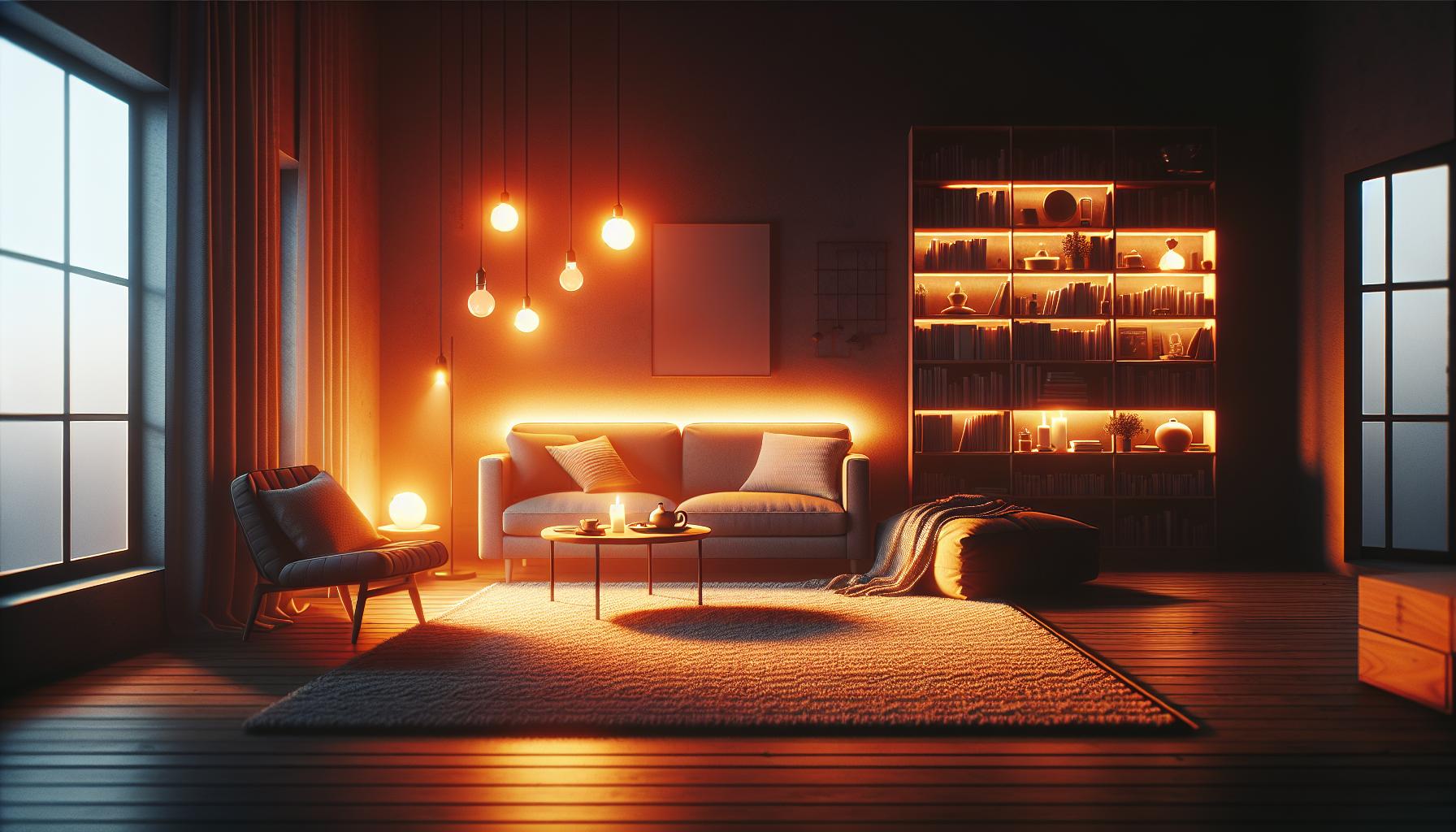Ever wondered why some light bulbs cast a warm, orange glow instead of a stark white light? It’s all about setting the mood. The orange hue you’re seeing is actually by design, and it’s got a lot to do with how you feel in a space.
These cozy orange bulbs are a staple in places where a relaxing ambiance is key. Think about your favorite cafe or a snug reading nook. But there’s more to it than just the vibe—there’s science behind why orange light can be so inviting. Let’s dive into the colorful world of light bulbs and uncover the reasons behind their sunset-like glow.
What causes light bulbs to have an orange glow?
Ever wandered down the lighting aisle and noticed how some bulbs promise a “warm white” light? Well, that’s your clue to the cozy orange glow you’re curious about. The color of the light emitted by a bulb is determined by its color temperature—a concept in lighting that’s akin to setting the mood in your favorite nook.
Color Temperature and Kelvins—these are your keywords. Measured in Kelvins (K), the scale goes from warm to cool. Think of the lower end, around 1,000 to 3,000K, where you’ll find that inviting orange hue likened to the embers of a campfire. As you move up towards 6,000K or more, the light becomes bluer, like the midday sun.
So, how do these bulbs pull it off? Incandescent bulbs, the classic kind, naturally emit a warmer light due to the heated filament inside glowing with that familiar orange tint. You know, the one that makes a room feel like a snug blanket? But, with the rise of LED technology, achieving that same warmth is all about some clever engineering. By adjusting the materials and coatings within the LED bulb, manufacturers can simulate the same warm glow without all the heat.
Here’s a nifty fact: An LED light often contains phosphor coatings that transform the color. When the blue light from the LED chip hits these coatings, it morphs into that toasty orange glow. Magic? Almost. Science? Absolutely.
Your lighting choice doesn’t just illuminate; it sets the tone for your entire space. Whether it’s for a chill lounge area or the more delicate ambiance needed for a tranquil reading session, understanding the mechanics behind your light bulbs’ color can immensely affect the atmosphere you’re aiming to create. Remember, the glow isn’t just about aesthetics—it’s about the feel and function interplaying in your habitat.
The psychology of warm lighting
When you’re diving into the realm of home lighting, you’ll quickly discover that not all light is created equal. Warm lighting, the sort that leans heavily toward the orange end of the spectrum, does more than just brighten a room; it can profoundly impact the mood and feel of your space.
Warm light bulbs produce an effect similar to the glow of a sunset, which has deep psychological effects. Your body is hardwired to respond to this kind of light, associating it with relaxation and comfort – think about the soothing feeling you get while watching the sun dip below the horizon. It’s no wonder that many of your favorite restaurants and living spaces are bathed in warm, orange hues.
But it’s not just about a subconscious response. There’s science behind the emotional underpinnings of warm lighting:
- Melatonin, the sleep hormone, is more readily produced in the presence of warm light, preparing your body for rest.
- Warm light tends to reduce stress and anxiety, making it an excellent choice for bedrooms, living rooms, and other areas where you seek peace.
- In contrast to cool lighting, warm tones often enhance sociability and interaction, creating inviting environments for gatherings.
As a lighting enthusiast, you know that choosing the right color temperature isn’t just about aesthetics, but about catering to the psychological needs of the occupants. Whether you’re curled up with a book or hosting a dinner party, warm orange light sets the perfect stage for your activities. Current LED technologies allow you to fine-tune your lighting preferences to suit any occasion without sacrificing energy efficiency or longevity.
So, as you plan your next home DIY project, consider the psychological implications of your lighting choices. Lighting isn’t just a practical necessity; it’s a cornerstone of home design that can subtly influence the emotional well-being of you and your guests.
The science behind orange light
« What Is the Problem with Light Bulbs? Unveiling the Shocking Truth
Why Is Light Bulbs Used: The Future of Smart & Eco-Friendly Lighting »
Think of an orange glow as a warm embrace for your space. As you delve into do-it-yourself home projects, you’ll be thrilled to learn that the secret behind this inviting aura is rooted in science. The hue of a light bulb is determined by its color temperature, measured in degrees Kelvin. Warm light bulbs, which radiate an orange hue, have a lower color temperature, typically ranging from 2,700 to 3,000K.
- Lower Kelvin numbers mean the light appears more orange or yellow.
- Higher Kelvin numbers result in a bluer, daylight-like quality.
Orange light simulates the tones of sunrise or sunset, times traditionally associated with calmness and relaxation. That’s why your evening retreats feel more peaceful under the auspice of these amber tones. Your brain actually responds to the orange spectrum by reducing the production of melatonin, the hormone that signals your body to prepare for sleep.
Here’s a quick look at how color temperature ranges relate to light appearance:
| Color Temperature (Kelvin) | Light Appearance |
|---|---|
| 1,000 – 2,000K | Candlelight |
| 2,700 – 3,000K | Warm White |
| 3,000 – 4,500K | Neutral/Cool White |
| 4,500 – 6,500K | Daylight |
When engaging in a DIY lighting project, understanding the importance of the spectral power distribution (SPD) is crucial. SPD provides a visual profile of which wavelengths are emitted by your bulb. Orange light, packed with red to yellow wavelengths, creates an inviting atmosphere that can simply transform a room with the flick of a switch.
Don’t just think brightness; think quality. That’s how you’ll set the right mood every time. Whether you’re cozying up with a book or hosting a dinner party, the orange lights will ensure the setting is nothing short of enchanting. Keep in mind that dimmers can further tweak this warm ambiance, letting you switch from vibrant to mellow as the evening progresses.
Benefits of using orange light bulbs
Orange light bulbs aren’t just an aesthetic choice—they come packed with a variety of benefits that extend beyond their warm glow. As you dive into your next home DIY project, consider how these bulbs can enhance not only your décor but also your quality of life.
Biological Advantages: The human body responds to light in ways you might not anticipate. The warm hue of orange bulbs can help regulate your circadian rhythm, which is crucial for a good night’s sleep. Unlike the harsh blue light emitted by many LED bulbs, orange light minimizes disruption to your sleep-wake cycle. It’s the kind of atmosphere that whispers, ‘relax’ after a long day.
Psychological Comfort: There’s a psychological component to lighting that can’t be ignored. Orange light often evokes feelings of warmth and coziness, perfect for creating a snug environment. In spaces where you want to unwind or socialize, the soft illumination from these bulbs can make you and your guests feel more at ease. It’s like your living room is giving you a gentle hug.
Aesthetic Flexibility: From a design standpoint, the versatility of orange light bulbs is remarkable. They can introduce a rustic, vintage charm to a room or underscore a modern, minimalist space with just the right touch of warmth. These bulbs also play well with many different materials and color palettes, making them a go-to for creative lighting solutions.
If you’re looking to harness the full potential of orange bulbs, don’t overlook dimmers. The ability to adjust the light intensity can dramatically alter the ambiance of a room. Picture softening the light to a gentle glow for a romantic dinner or brightening it for a lively game night. With dimmers, you have full control over the mood you want to set.
As you choose the perfect lighting, remember that the effects of orange light can transform the simplest of spaces into welcoming havens. Whether it’s for your own sanctuary or a place where friends gather, these bulbs offer both charm and function in spades.
Conclusion
So next time you’re looking to switch up your space remember that orange light bulbs are more than just a pretty glow. They’re a smart choice for your well-being and decor. With the ability to fine-tune the ambiance to your liking you’ll see how these bulbs transform your environment into a sanctuary that beckons relaxation and tranquility. Go ahead and give them a try—you might find that they’re exactly what you needed to create the perfect atmosphere in your home or office.
Frequently Asked Questions
What are the benefits of using orange light bulbs?
Orange light bulbs enhance the aesthetic appeal of a space, provide psychological comfort, help regulate circadian rhythms, and promote better sleep quality.
How do orange light bulbs affect sleep?
Orange light bulbs emit light that is similar to a sunset, which can help signal the body to prepare for sleep by regulating the circadian rhythm, thus promoting better sleep.
Can orange light bulbs create a cozy atmosphere?
Yes, the warm glow of orange light bulbs can create a cozy and inviting atmosphere in a space, making it feel more relaxing and comfortable.
Are orange light bulbs versatile in design?
Orange light bulbs are versatile in interior design and can complement various decor styles by adding a charming touch to the space.
Is an orange light bulb compatible with dimmers?
Yes, using dimmers with orange light bulbs allows you to adjust the intensity of the light to set the mood and ambiance as desired.




